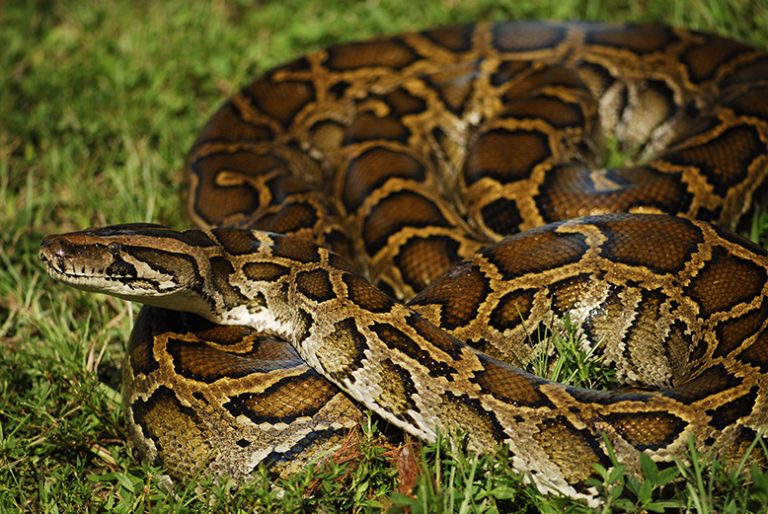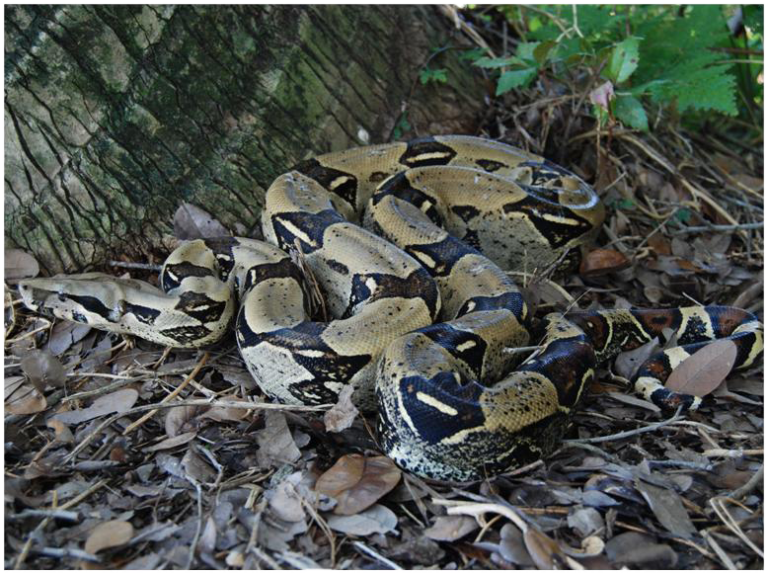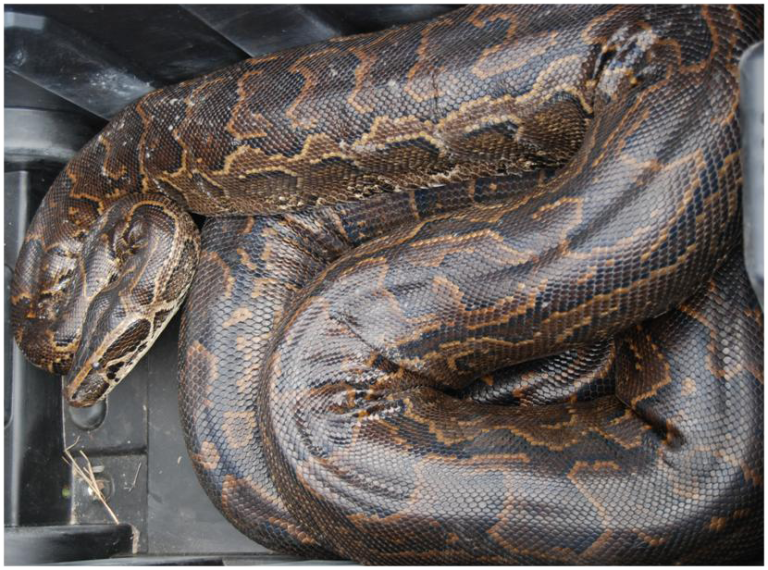Burmese Python (Python molurus bivittatus)
and other nonnative constrictors
Origin:
Burmese python: Southeast Asia
Northern African python: Africa
Common boa: Central and South America
Introduction to Florida:
Escaped or released pets
Stage on Invasion Curve:
Burmese python: Resource Protection & Long-term Management
Northern African python: Containment
Common boa: Eradication



Description
Nonnative constrictors are much longer and heavier than any of Florida’s native snakes, routinely growing to more than seven feet long. Their scales appear smooth, unlike the rough, textured scales of native water snakes.
Burmese pythons (Python molurus bivittatus) and Northern African pythons (Python sebae) can grow up to 20 feet long. Burmese pythons are tan in color with dark “giraffe” blotches on the back and sides that are irregularly shaped and fit together like puzzle pieces. The Northern African python looks similar, but the spots on its back usually connect and form a less-defined pattern. Also, the bellies of Northern African pythons are completely speckled, compared to Burmese pythons which have pale bellies. Both species have a dark arrowhead shape on top of the head and a dark wedge behind the eye.
The common or red-tailed boa (Boa constrictor) usually reaches lengths of 6–10 feet. The body is marked down the back and sides with tan ovals. Toward the tail, the saddle-like ovals become narrow bands separated by reddish saddles.
Other species of nonnative constrictor that have been found in South Florida include the reticulated python (Python reticulatus), ball python (Python regius), green anaconda (Eunectes murinus), and yellow anaconda (Eunectes notaeus). These collections are likely of escaped or released pets and none of these species are believed to be reproducing or established in Florida.
Impacts
Burmese pythons are a threat to native wildlife and ecosystems of South Florida. Their presence has led to severe declines in Everglades mammal populations. They are known to eat imperiled species such as wood storks, Key Largo woodrats, and limpkins, as well as large animals such as alligators, white-tailed deer, and bobcats. They also compete with native predators for food, habitat, and space. Other species of nonnative constrictor would likely have similar impacts to Burmese pythons if they were to grow in number in South Florida. Thanks to the rapid response of wildlife managers, Northern African pythons have not invaded South Florida beyond a small area of Miami.
Where to Find Them
Burmese pythons have large breeding populations in Miami-Dade, Monroe and Collier counties, mainly within and around the Florida Everglades. The common boa is established in a very small area within Miami. Northern African pythons are the target of eradication efforts in a small area on the outskirts of Miami. Pythons are typically found near wetlands or open bodies of water, and are most commonly seen while basking on roads, levees or embankments. Boas inhabit a variety of habitats and are more arboreal (tree-dwelling) than the other large constrictors established in Florida.
Distribution:
What You Can Do
- Learn to identify Florida’s native snakes and tell them apart from exotic species.
- If you see a Burmese python or other nonnative constrictor, please take a picture, note the location, and report your sighting:
- By phone: 1-888-IVE-GOT1
- Online: IveGot1.org
- Or download the IveGot1 reporting app
- If you live near affected areas, you can make your yard less attractive to Burmese pythons by removing excess debris and maintaining landscaping.
- Do your research before buying an exotic pet, and remember, Don’t Let It Loose!
- Surrender unwanted exotic pets at one of FWC’s Exotic Pet Amnesty Day events or call the Pet Amnesty hotline at 1-888-IVE-GOT1
More Information
Brochures and Fact Sheets:
- Burmese Pythons in Florida: Help Stop the Spread of an Invasive Snake (FWC)
- Nonnative Reptiles in South Florida: Identification Guide (UF)
- “Florida Invaders” series (UF)
- REDDy publication series (UF)
- Pest Alert: Northern African Python
- The Invasion of Exotic Reptiles and Amphibians in Florida (UF)






